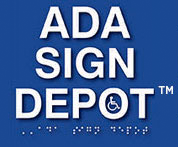Disability Etiquette
ADA Sign Depot
September 21, 2013

Disability Etiquette
People with disabilities are entitled to the same courtesies you would extend to anyone, including personal privacy. If you find it inappropriate to ask people about their sex lives, or their complexions, or their incomes, extend the courtesy to people with disabilities.
- If you don’t make a habit of leaning or hanging on people, don’t lean or hang on someone’s wheelchair. Wheelchairs are an extension of personal space.
- When you offer to assist someone with a vision impairment, allow the person to take your arm. This will help you to guide, rather than propel or lead, the person.
- Treat adults as adults. Call a person by his or her first name only when you extend this familiarity to everyone present. Don’t patronize people who use wheelchairs by patting them on the head. Reserve this sign of affection for children.
In conversation…
- When talking with someone who has a disability, speak directly to him or her, rather than through a companion who may be along.
- Relax. Don’t be embarrassed if you happen to use common expressions, such as “See you later” or “I’ve got to run”, that seem to relate to the person’s disability.
- To get the attention of a person who has a hearing disability, tap the person on the shoulder or wave your hand. Look directly at the person and speak clearly, slowly and expressively to establish if the person can read your lips. Not everyone with hearing impairments can lip-read. Those who do will rely on facial expressions and other body language to help understand. Show consideration by facing a light source and keeping your hands and food away from your mouth when speaking. Keep mustaches well-trimmed. Shouting won’t help, but written notes will.
- When talking with a person in a wheelchair for more than a few minutes, place yourself at the wheelchair user’s eye level to spare both of you a stiff neck.
- When greeting a person with a severe loss of vision, always identify yourself and others who may be with you. Say, for example, “On my right is Andy Clark”. When conversing in a group, remember to say the name of the person to whom you are speaking to give vocal cue. Speak in a normal tone of voice, indicate when you move from one place to another, and let it be known when the conversation is at an end.
- Give whole, unhurried attention when you’re talking to a person who has difficulty speaking. Keep your manner encouraging rather than correcting, and be patient rather than speak for the person. When necessary, ask questions that require short answers or a nod or shake of the head. Never pretend to understand if you are having difficulty doing so. Repeat what you understand. The person’s reaction will guide you to understanding.
Common courtesies…
- If you would like to help someone with a disability, ask if he or she needs it before you act, and listen to any instructions the person may want to give.
- When giving directions to a person in a wheelchair, consider distance, weather conditions and physical obstacles such as stairs, curbs and steep hills.
- When directing a person with a visual impairment, use specifics such as “left a hundred feet” or “right two yards”.
- Be considerate of the extra time it might take a person with a disability to get things done or said. Let the person set the pace in walking and talking.
- When planning events involving persons with disabilities, consider their needs ahead of time. If an insurmountable barrier exists, let them know about it prior to the event.
- Tags: ADA People Subscribe to this blog's RSS feed.


